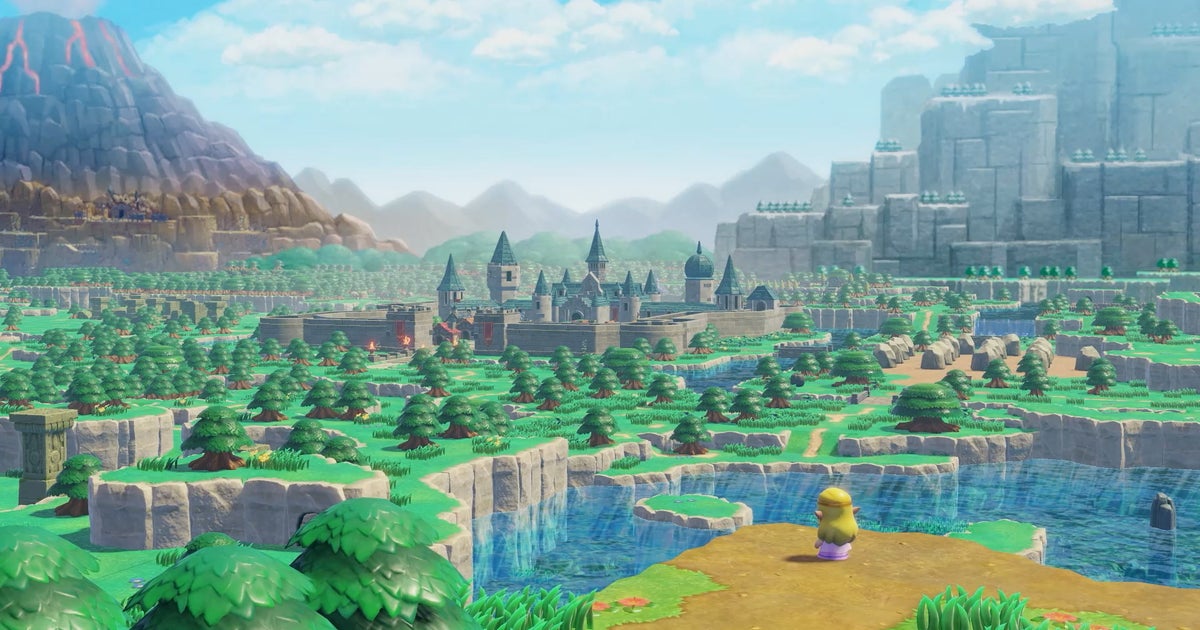Thanks to playful puzzles and an imaginative reinvention of Hyrule’s historic iconography, Echoes of Wisdom emerges as a bold and creative new chapter in Zelda’s legend.
For a series approaching its 40th birthday, Princess Zelda’s moment to take centre stage in her own legend has been a long time coming. She came close in 2009’s Spirit Tracks, even if it was as a ghost locked inside a suit of armour, and we felt her presence at almost every turn in 2023’s Tears of the Kingdom – an impressive feat considering the time and distance separating her from your over and underground ramblings. But even in her brightest moments, Zelda has always played second fiddle to her sword-wielding hero Link. Until now, where it’s Link who gets spirited away by the latest evil being of the day, and it’s Zelda who must finally restore the world of Hyrule to rights.
It’s a shake-up that feels long overdue, but simply being able to play as Zelda is arguably the least interesting thing about Echoes of Wisdom overall. This is a game of quiet defiance almost everywhere you look. From its citizens reckoning with how the old way of doing things just doesn’t cut it anymore, right down to the choice of tools Zelda has to navigate the world the around her, you can sense Echoes of Wisdom wrestling with the expectations of what a Zelda game even is anymore now we’re in its post-Breath of the Wild era. Happily, it does so to often joyful and playful effect, showing how its smaller and more traditional outings can continue to exist alongside its sprawling open world epics.
There are moments where it’s not wholly successful, but let’s be honest, any game stepping out of the shadow of both Breath of the Wild and Tears of the Kingdom can’t help but come away feeling a little diminished by comparison. It’s a daunting prospect, but it’s a path that Echoes of Wisdom treads boldly over the course of 30 or so hours, showing just what a Zelda game can be when you take TOTK’s freeform, build-your-own adventure blocks and apply them to the familiar bones of a Hyrule that’s been with us since the days of A Link to the Past (now with an added ring of new terrain round its well-worn edges). It’s a potent and dizzying mix, and one that makes Princess Zelda’s first outing as its series lead feel wholly and distinctly hers.
You might not think so to look at it, though, as Zelda must begin her adventure on the run, donning Link’s cloak as a disguise to evade imposters from Hyrule Castle who are baying for her execution. It’s a surprisingly dark setup, all things considered, but one that leads to the perfect introduction of its main hook: the titular Echoes. With the help of Tri, a dreamy, floating candy droplet of a fairy, Zelda gains the ability to make copies of all manner of objects and creatures, from small, half-height tables to great stomping Moblin monsters. She can even make an Echo of her own bed to have a little sleep and restore some health – a truly royal indulgence that brings new meaning to the phrase ‘power nap’. But the best of these early Echoes is undoubtedly the humble pot. Where Link would normally hoist and hurl these against a wall to harvest the rupees within, Zelda can hop inside and channel her inner Solid Snake, slipping through enemy patrols with the kind of audacity we rarely see from our man in green.
This mischievous and imaginative eye for bringing magic to the mundane only grows stronger as the game goes on. Without giving too much away, there were several moments where getting to grips with a new Echo put a big delirious grin on my face, and I haven’t seen such inventive uses of water and clouds since Super Mario Galaxy. Manipulating these Echoes to reach all sorts of nooks and crannies in its gorgeous, almost toy model-like map captures the same kind of delight I felt playing Breath of the Wild for the first time, as though you’re sculpting the world to your will, and it bends and leans right back with you.
It’s not just everyday objects that Zelda can turn to her advantage, either. She can also make Echoes of the series’ classic monsters once they’ve been defeated for the first time, allowing her to pit their claws, fangs and spears against one another like an impromptu Pokémon battle. Admittedly, Zelda can feel a little surplus to requirements in these moments, as she has no real way to deal damage herself, and her monster menagerie operates completely autonomously once summoned. Instead, Zelda has to sit on the sidelines and circle the action at a distance, sending in more Echoes if they get demolished, but generally staying out of harm’s way. Sitting on the sidelines is an odd feeling for a Zelda game, and it can make the moment-to-moment action of Echoes of Wisdom feel a little deflating as a result. There’s still a certain thrill in matching the right monster to the right enemy – zippy Rope snakes can easily dodge airborne Crow and Keese attacks, for example – but the itch to throw yourself into the heat of battle never truly goes away.
It’s a tension that Nintendo and the game’s developer Grezzo are both clearly aware of as well, and their collective compromise is Zelda’s Swordfighter form. Even though Link is absent for most of the game, stuck inside one of the ominous dimensional rifts that have ruptured across Hyrule (and from which those nasty, bloodthirsty imposters keep slinking out of), Zelda can still wield his Sword of Might, as well as his bow and, eventually, bombs. It’s a transformation that’s met with a flurry of triumphant musical motifs, a heightened tempo and, most crucially, a rapidly dwindling energy bar that really puts the kibosh on how long you’re able to maintain this overpowered disguise. It’s so limited, in fact, that even walking towards an enemy or boss on the other side of a room feels like you’re wasting precious attacking time, making it really a ‘break glass in case of emergency’ kind of ability than something you can whip out at any moment.
Personally, I think this is the right call, for as much as I still want to fight alongside my Moblins, Wizzrobes and Darknuts, the short-lived nature of your Swordfighter form does mean the focus remains squarely on its all-important Echoes. Anything more, and it would just feel like another Zelda game in Link’s clothing, which would be a real shame, not to mention a disservice to who Zelda is as a character. Instead, it gives Echoes of Wisdom the space to breathe and be its own experience, nudging its players toward creative experimentation and really getting to know the ins and outs of each monster and item at your disposal – how the quick reflexes of a Lizalfos can best the slow wind-ups of a Boarblin, for example, or how larger hordes can be separated and singled out with the distracting aroma of a well-placed meat roast (or in the case of ghosts, a really quite creepy teddy bear).
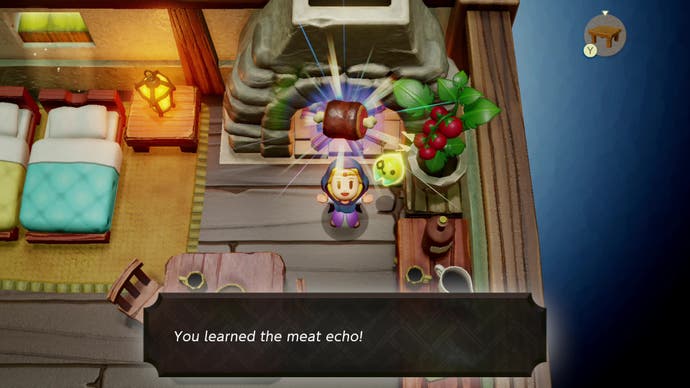
Of course, with over 120 Echoes to learn, you’ll no doubt settle on a handful of favourites over time, both when it comes to combat and solving its more cerebral dungeon puzzles. Indeed, there are times when you’ll ask, ‘Do we really need four kinds of decorative statue that are all the same height and width?’ Probably not. Likewise, when some Echoes start appearing in Lv.2 and Lv.3 variants, there’s little reason to ever go back to the weaker original. Similarly, while I was thrilled to see Zelda II’s floating Moa eye make an appearance amongst other series deep cuts, these more extraneous Echoes felt like more of a wink to long-term fans than anything truly revolutionary.
But like BOTW and TOTK before it, having so many options to play with does leave the door open for a more creative kind of problem solving, and Echoes of Widsom’s best moments here capture the same kind of kitbashing brilliance as Link’s Ultra Hand powers. While some puzzles are clearly made with particular Echoes in mind, it’s equally easy to find others that can be approached from all sorts of angles – and when each Echo has its own associated summoning cost, even working out how to cross a large gap can become an exercise in devious innovation. Who needs a hookshot when you can build a bridge of beds and tables, or catch a ride on a Flying Tile?
Tri takes another leaf out of TOTK’s Ultra Hand book by allowing Zelda to possess certain objects as well, dragging them around as well as ‘following’ their respective movement patterns, opening up the possibility to hang from the underside of a platform, say, or scale a cliff off the back of a spider. Alas, these aren’t quite as developed as Link’s glowing forearm, as the distance and direction Zelda faces can’t be altered manually through the controls, and the ‘follow’ command in particular starts to feel increasingly underutilised as you amass more Echoes. Once again, it’s the kind of shortcoming that feels like it’s chafing against what we know Zelda games can be. But like the Swordfighter form, I do think these limitations allow players to dig just a little bit deeper and come up with more creative and novel solutions, as if to say, ‘You’ve seen what’s possible at the height of Link’s powers – now have another go on hard mode’.
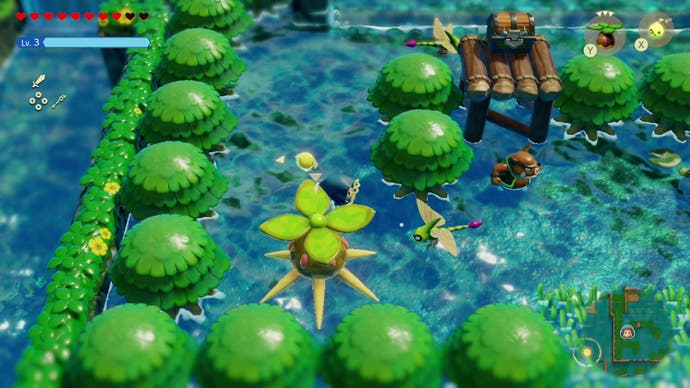
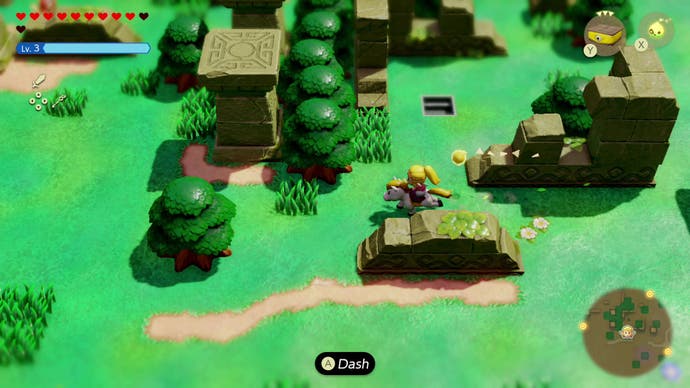

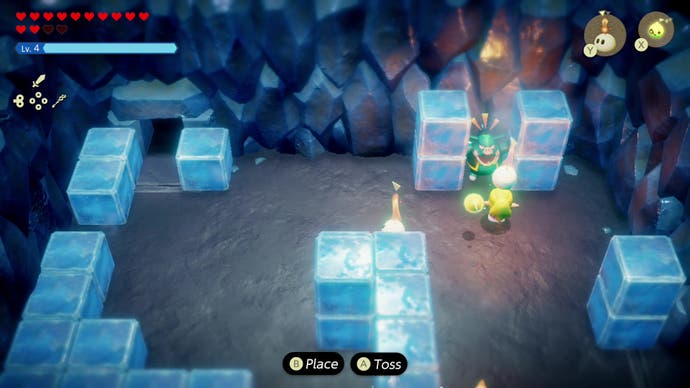
One area where this pared back approach does fall a little flat, however, is its dungeons, which are arguably some of the series’ weakest in recent memory. There are seven of them altogether, each submerged in a rift in a far-flung corner of Hyrule where simply getting to the front door is all part of their wider puzzle. It’s very Skyward Sword in that sense, but the build-up is frequently the most memorable and enjoyable thing about them, whether it’s acting as mediator between two warring Zora clans or delivering rock roast dinners to exhausted Gorons. Traversing the rifts themselves – known here as the Still World – also showcases some of Echoes of Wisdom’s finest traversal puzzles, with chunks of landscape arranged all askew in the void so that tree trunks become makeshift bridges, and shallow water pools suddenly extend into deep, ocean-like trenches. It’s enough to make you wonder what this game’s development team might do if it ever got its hands on Mario himself. But once you’re in the dungeon proper, however, that eager anticipation dissipates much faster than you’d like.
Echoes of Wisdom’s dungeons are very much in the mould of A Link to the Past, with small keys, big keys and maps that must be found before you can face the big boss. There’s also a hint of A Link Between Worlds here, too, both in the sense that none of them are geared around any particular Echoes or items, and because you’re often free to approach them in any order you like. But whereas ALBW countered this freeform approach with clever applications of its shape-shifting powers and perspective tricks, Echoes of Wisdom is much more straightforward. There are small moments of brilliance here and there, but I mostly found myself sleepwalking through a lot of them, and they’re all so bland that few really stick in the memory.
In fairness, dungeons are something even Breath of the Wild and Tears of the Kingdom have struggled to nail down this generation, but even Echoes of Wisdom’s best attempts feel like watered down versions of what’s come before. Once you’ve sailed across lava vents and pumped multiple switches to raise water levels once, it’s hard to be wowed by them again unless they’re turned completely on their head. Echoes of Wisdom never quite manages this, and instead plays things safe. Here, it really does feel like another Zelda game in Link’s clothing, and it’s all the more disappointing for it.

There are a couple of other hangovers from BOTW and TOTK that feel outright redundant as well, such as accessories and smoothie recipes that increase your climbing speed when there’s no stamina bar to speak of, and the longest time you’ll spend doing it can be measured in single digit seconds. There are also smoothies that make you glow in the dark, which I’d argue are only really needed in one location here, and even then gets outshone by more illuminating Echoes at your disposal.
Likewise, the mechanical, wind-up Automatons you can obtain in the latter half of the game come too late to really unseat your most trusted Echo squad at that point. They’re good fun on paper (and have wonderfully techy names to match), but as much as I delighted in seeing a robotic Moblin wield a katana with anime-esque extravagance, the process of winding it up and then waiting for its animation to trigger took so long that battles would often end before it had even managed its first swing. There’s a kernel of something brilliant here, though, and if this is the first draft of something bigger for these Automaton gizmos, I’d love to see where Nintendo takes them next.
Still, even through its missteps and occasional dead-ends, Echoes of Wisdom is rarely content to just sit on its laurels. It forges its own path at almost every turn, challenging our understanding and expectations of how Hyrule’s flora and fauna can behave, while also unearthing new wrinkles that make its well-worn highways feel fresh and exciting again. For all Zelda’s apparent helplessness, the joy of discovering new Echoes and monster abilities never abates, drawing you deeper into its world instead of pushing you out of it. Ultimately, it’s a plucky and inventive spin on everything we know Zelda to be, reconciling the new and the old to create its own unique legacy, and a legend that befits a heroine who’s waited nearly four decades to own it – and all without becoming an unwilling puppet in someone else’s story (because let’s face it, Zelda’s no stranger to having her strings pulled at the eleventh hour). Far from being a case of chronic imposter syndrome, Echoes of Wisdom rises to the occasion with a lively and majestic confidence. Here’s hoping we don’t have to wait another 40 years before Zelda gets another shot at saving her hero again.
A copy of The Legend of Zelda: Echoes of Wisdom was provided for review by Nintendo.

